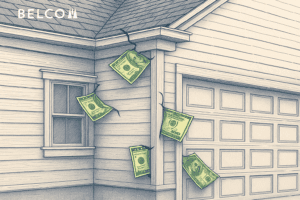Drip edge is a commonly overlooked component of the gable end system. Far too often gable ends are installed with the bargeboard, and then considered complete. While in theory and according to code they are finished. However, it is very easy to take one small inexpensive step to protect the bargeboard. Simply installing a drip edge keeps the home looking great for years to come.
Drip edge is most commonly a piece of 1×2 or 1×3 material that is fastened at the top of the bargeboard following the same angle of the gable end. The sole purpose of the drip edge is to make an attachment point for the flashing that runs over the gable while spacing the flashing an inch off the bargeboard.
This space serves two purposes; first, it is architecturally pleasing as it provides added shadow lines and gable end detail. Second and more importantly, by stepping the flashing off the bargeboard avoiding black streaking down the face of the gable ends.
Black streaking is caused by water that is blown across the roof, slides down the flashing, and then running down the bargeboard until it drips off to the ground. The black marks left behind are a combination of mold/mildew spores mixed with dirt and debris that accumulate on all roofs over time. The black streaks unappealing to see. But they are also just a symptom of a gable end bargeboard setup to prematurely fail due to rot.
Material Selection
There are a few common material choices for drip edge, and all have their pros and cons. Now that we know why drip edge is used, we will dive into which material might be best for your next home.
Fiber Cement As Drip Edge
There really isn’t a great fiber cement trim option for drip edge due to the brittle nature of the product. Fiber cement is brittle in larger sizes like 5/4×6. So, a 1×2 is really asking for trouble from breakage. Also, the 12’ lengths create more joint seams creating opportunity for potential water intrusion.
The closest fiber cement comes to a true drip edge in terms of sizing is a 1×4. Although this can work, it is not ideal for a variety of reasons. First it will not be fully covered by the standard flashings available on the market today. Also, due to the width of the “drip edge” being 3.5” net. It will make the barge look smaller in comparison.
To counteract this concern is to build with bigger barge material like 5/4×12 or 2×12, but that adds a lot of unnecessary costs. All in a world where builders are looking to save money every where they can. Overall fiber cement is a very durable product once installed; however, it just isn’t well suited to this application.
OSB/Hardboard
Oriented Strand Board (OSB) and Hardboard based products get a little closer to the mark size wise than fiber cement with the option for a 1×3 which nets somewhere around 5/8”x2 1/2”. Now we are getting closer to true dip edge sizing.
OSB and hardboard-based products are offered in 16’ lengths creating fewer seams than fiber cement. Size and lengths are reasons why these OSB based products make more sense than Fiber cement.
But there is a downside. The biggest concern to an OSB or hardboard style drip edge is edge swelling along the exposed edges. Edge swelling is caused by water intrusion along the vulnerable edges. As long as the flashing is properly installed, swelling should be minimal. However, these drip edge products tend to edge swell if water is driven between the flashing and the drip edge.
Remember, the sole purpose of the drip edge is to allow for the flashing to be attached off the face of the bargeboard. Protecting it from water intrusion and black streaking. So, the drip edge is quite literally being used to deflect water in conjunction with the flashing.
Cedar and Redwood
Traditionally Western Red Cedar and Redwood have been used for drip edge. The natural decay resistant properties of these two wood species work well to resist rot. But heartwood is truly the only part resistant to rot naturally. Sapwood carries none of the properties to resist rot.
In today’s market, prices of Western Red Cedar and Redwood have made products made from these products less attractive. Additionally, long lengths have also been in short supply. The additional number of joint seams have made users of these popular natural exterior wood products looking to alternatives.
Primed White Wood For Drip Edge
Primed white wood is a cost effective, durable product for drip edge. Sure, it has the tendency to have some fiber movement in small sizes like 1×2. But it can also be straightened and nailed right back to perfect position.
The perfect size for drip edge is 1×2 since most flashing completely cover and protect it meaning its only true job is to act as a spacer. The length structure offered as heavy long lengths makes for few if any joint seams. Also, very little waste per gable is caused in trimming to fit.
Primed white wood is more resistant to broken pieces during installation when compared to OSB, hardboard, or fiber cement products.
Preservative Treated & Primed White Wood For Drip Edge
Preservative treated and primed Belco XT® Trim is the true winner in the drip edge category. Belco XT® Trim is a primed whitewood product. It takes protection one step further. The Wolman® AG preservative treatment system is included in every stick at no extra cost. Belco XT® trim is the perfect material for drip edge. It is preservative treated to protect against rot, mold, and mildew, the sizing is perfect for commonly available flashing products, plus it is durable and easy to install. Most importantly Belco XT® Trim will serve your gable end barge system for years to come. Protecting against rot and mold while eliminating those unsightly black streaks. Follow this link to see more about Belco XT® Trim https://belcofp.com/products/xt-trim/.












